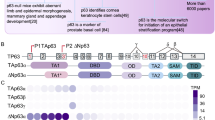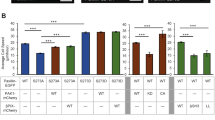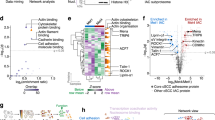Abstract
p63 is critical for epithelial development yet little is known about the transcriptional programmes it regulates. By characterising transcriptional changes and cellular effects following modulation of p63 expression, we have defined a vital role for p63 in cellular adhesion. Knockdown of p63 expression caused downregulation of cell adhesion-associated genes, cell detachment and anoikis in mammary epithelial cells and keratinocytes. Conversely, overexpression of the TAp63γ or ΔNp63α isoforms of p63 upregulated cell adhesion molecules, increased cellular adhesion and conferred resistance to anoikis. Apoptosis induced by loss of p63 was rescued by signalling downstream of β4 integrin. Our results implicate p63 as a key regulator of cellular adhesion and survival in basal cells of the mammary gland and other stratified epithelial tissues.
This is a preview of subscription content, access via your institution
Access options
Subscribe to this journal
Receive 12 print issues and online access
$209.00 per year
only $17.42 per issue
Buy this article
- Purchase on Springer Link
- Instant access to full article PDF
Prices may be subject to local taxes which are calculated during checkout








Similar content being viewed by others
References
Fuchs, E. & Raghavan, S. Getting under the skin of epidermal morphogenesis. Nature Rev. Genet. 3, 199–209 (2002).
Mills, A. A. et al. p63 is a p53 homologue required for limb and epidermal morphogenesis. Nature 398, 708–713 (1999).
Yang, A. et al. p63 is essential for regenerative proliferation in limb, craniofacial and epithelial development. Nature 398, 714–718 (1999).
Koster, M. I., Kim, S., Mills, A. A., DeMayo, F. J. & Roop, D. R. p63 is the molecular switch for initiation of an epithelial stratification program. Genes Dev. 18, 126–131 (2004).
Hibi, K. et al. AIS is an oncogene amplified in squamous cell carcinoma. Proc. Natl Acad. Sci. USA 97, 5462–5467 (2000).
Westfall, M. D. & Pietenpol, J. A. p63: Molecular complexity in development and cancer. Carcinogenesis 25, 857–864 (2004).
McKeon, F. p63 and the epithelial stem cell: more than status quo? Genes Dev. 18, 465–469 (2004).
Yang, A. et al. p63, a p53 homolog at 3q27-29, encodes multiple products with transactivating, death-inducing, and dominant-negative activities. Mol. Cell 2, 305–316 (1998).
King, K. E. et al. δNp63α functions as both a positive and a negative transcriptional regulator and blocks in vitro differentiation of murine keratinocytes. Oncogene 22, 3635–3644 (2003).
Dohn, M., Zhang, S. & Chen, X. p63α and δNp63α can induce cell cycle arrest and apoptosis and differentially regulate p53 target genes. Oncogene 20, 3193–3205 (2001).
Wu, G. et al. δNp63α and TAp63α regulate transcription of genes with distinct biological functions in cancer and development. Cancer Res. 63, 2351–7235 (2003).
Ellisen, L. W. et al. REDD1, a developmentally regulated transcriptional target of p63 and p53, links p63 to regulation of reactive oxygen species. Mol. Cell 10, 995–1005 (2002).
Kurata, S. et al. p51/p63 controls subunit α3 of the major epidermis integrin anchoring the stem cells to the niche. J. Biol. Chem. 279, 50069–50077 (2004).
Dellavalle, R. P. et al. CUSP/p63 expression in rat and human tissues. J. Dermatol. Sci. 27, 82–87 (2001).
Pellegrini, G. et al. p63 identifies keratinocyte stem cells. Proc. Natl Acad. Sci. USA 98, 3156–3161 (2001).
Nylander, K. et al. Differential expression of p63 isoforms in normal tissues and neoplastic cells. J. Pathol. 198, 417–427 (2002).
Debnath, J., Muthuswamy, S. K. & Brugge, J. S. Morphogenesis and oncogenesis of MCF-10A mammary epithelial acini grown in three-dimensional basement membrane cultures. Methods 30, 256–268 (2003).
Shimada, A. et al. The transcriptional activities of p53 and its homologue p51/p63: similarities and differences. Cancer Res. 59, 2781–2786 (1999).
Nishi, H. et al. p53 homologue p63 represses epidermal growth factor receptor expression. J. Biol. Chem. 276, 41717–41724 (2001).
Reginato, M. J. et al. Integrins and EGFR coordinately regulate the pro-apoptotic protein Bim to prevent anoikis. Nature Cell Biol. 5, 733–740 (2003).
Frisch, S. M. & Francis, H. Disruption of epithelial cell-matrix interactions induces apoptosis. J. Cell Biol. 124, 619–626 (1994).
Meredith, J. E., Jr., Fazeli, B. & Schwartz, M. A. The extracellular matrix as a cell survival factor. Mol. Biol. Cell 4, 953–961 (1993).
Rytomaa, M., Martins, L. M. & Downward, J. Involvement of FADD and caspase-8 signalling in detachment-induced apoptosis. Curr. Biol. 9, 1043–1046 (1999).
Reginato, M. J. et al. Bim regulation of lumen formation in cultured mammary epithelial acini is targeted by oncogenes. Mol. Cell Biol. 25, 4591–4601 (2005).
Weaver, V. M. et al. β4 integrin-dependent formation of polarized three-dimensional architecture confers resistance to apoptosis in normal and malignant mammary epithelium. Cancer Cell 2, 205–216 (2002).
Mills, A. A., Qi, Y. & Bradley, A. Conditional inactivation of p63 by Cre-mediated excision. Genesis 32, 138–141 (2002).
Li, N. et al. TA-p63-γ regulates expression of δN-p63 in a manner that is sensitive to p53. Oncogene 25, 2349–2359 (2006).
Ying, H., Chang, D. L., Zheng, H., McKeon, F. & Xiao, Z. X. DNA-binding and transactivation activities are essential for TAp63 protein degradation. Mol. Cell Biol. 25, 6154–6164 (2005).
Ihrie, R. A. et al. Perp is a p63-regulated gene essential for epithelial integrity. Cell 120, 843–856 (2005).
Lechler, T. & Fuchs, E. Asymmetric cell divisions promote stratification and differentiation of mammalian skin. Nature 437, 275–280 (2005).
Keyes, W. M. et al. p63 deficiently activates a program of cellular senescence and leads to accelerated aging. Genes Dev. 19, 1986–1999 (2005).
Jost, M., Huggett, T. M., Kari, C. & Rodeck, U. Matrix-independent survival of human keratinocytes through an EGF receptor/MAPK-kinase-dependent pathway. Mol. Biol. Cell 12, 1519–1527 (2001).
Dowling, J., Yu, Q. C. & Fuchs, E. β4 integrin is required for hemidesmosome formation, cell adhesion and cell survival. J. Cell Biol. 134, 559–572 (1996).
Zahir, N. et al. Autocrine laminin-5 ligates α6β4 integrin and activates RAC and NFκB to mediate anchorage-independent survival of mammary tumors. J. Cell Biol. 163, 1397–1407 (2003).
Gumbiner, B. M. Cell adhesion: the molecular basis of tissue architecture and morphogenesis. Cell 84, 345–357 (1996).
Nanba, D., Nakanishi, Y. & Hieda, Y. Changes in adhesive properties of epithelial cells during early morphogenesis of the mammary gland. Dev. Growth Differ. 43, 535–544 (2001).
Watt, F. M. & Hogan, B. L. Out of Eden: stem cells and their niches. Science 287, 1427–1430 (2000).
Fuchs, E., Tumbar, T. & Guasch, G. Socializing with the neighbors: stem cells and their niche. Cell 116, 769–778 (2004).
Tumbar, T. et al. Defining the epithelial stem cell niche in skin. Science 303, 359–363 (2004).
Gautier, L., Cope, L., Bolstad, B. M. & Irizarry, R. A. affy--analysis of Affymetrix GeneChip data at the probe level. Bioinformatics 20, 307–315 (2004).
Eisen, M. B., Spellman, P. T., Brown, P. O. & Botstein, D. Cluster analysis and display of genome-wide expression patterns. Proc. Natl Acad. Sci. USA 95, 14863–14868 (1998).
Carroll, J. S. et al. Chromosome-wide mapping of estrogen receptor binding reveals long-range regulation requiring the forkhead protein FoxA1. Cell 122, 33–43 (2005).
Acknowledgements
The authors would like to thank F. McKeon for p63 cDNAs and comments on the manuscript, M. Reginato (Drexel University College of Medicine) for helpful discussions and critical reading of the manuscript, P. Grosu and the Bauer Center for Genomics Research, Harvard University, for assistance with computational software. This work was supported by the Association for International Cancer Research (AICR) #04-156 (D.L.), the Deparment of Defense (DOD) Breast Cancer Research Program Awards DAMD17-01-1-0222 (M.B.) w81XWH-04-1-0512 (J.C.), National Institute of Dental and Craniofacial Research (NIDCR) DE15945-01, The Avon Foundation, and the Mary Kay Ash Charitable Foundation (L.E.), NCI CA080111, Breast Cancer Research Foundation, and DOD DAMD17-02-1-0692 (J.S.B.), National Institutes of Health (NIH) AR47898 (A.M.).
Author information
Authors and Affiliations
Corresponding author
Ethics declarations
Competing interests
The authors declare no competing financial interests.
Supplementary information
Supplementary Information
Supplementary Figures S1, S2, S3 and S4 (PDF 237 kb)
Supplementary Information
Supplementary Table S1 (XLS 139 kb)
Supplementary Information
Supplementary Table S2 (XLS 4044 kb)
Rights and permissions
About this article
Cite this article
Carroll, D., Carroll, J., Leong, CO. et al. p63 regulates an adhesion programme and cell survival in epithelial cells. Nat Cell Biol 8, 551–561 (2006). https://doi.org/10.1038/ncb1420
Received:
Accepted:
Published:
Issue Date:
DOI: https://doi.org/10.1038/ncb1420
This article is cited by
-
Hypoxia-activated XBP1s recruits HDAC2-EZH2 to engage epigenetic suppression of ΔNp63α expression and promote breast cancer metastasis independent of HIF1α
Cell Death & Differentiation (2024)
-
The long non-coding RNA NEAT1 is a ΔNp63 target gene modulating epidermal differentiation
Nature Communications (2023)
-
p63: a crucial player in epithelial stemness regulation
Oncogene (2023)
-
Integrated single-cell chromatin and transcriptomic analyses of human scalp identify gene-regulatory programs and critical cell types for hair and skin diseases
Nature Genetics (2023)
-
ΔNp63 regulates a common landscape of enhancer associated genes in non-small cell lung cancer
Nature Communications (2022)



